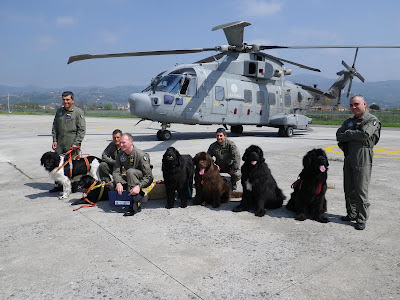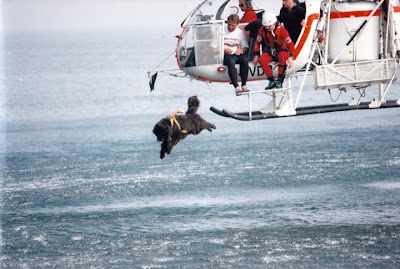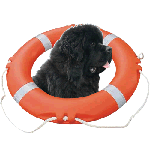







(Courtesy S.I.C.S.)
Real Water Rescue Work in Italy
SICS Operative Water Rescue Certificate®
This chapter describes the tests, which enable the SICS K9 Unit to be operative. The tests are not performed in a single day but during one or more years depending upon the different opportunities; they may be performed during some events that SICS itself promotes or during practical training or service events in cooperation with the Coast Guard or the Rescue Helicopters Organization.
The Operative Water Rescue Certificate was developed by the Italian School of Rescue Dogs SICS and it is the result of many experiences and situations the school itself has worked in with the cooperation of the Coast Guard – Port Authorities. It meets the operative specifications of Rescue Cruisers, HH3F Pellican SAR Air Rescue and AB212 Air Force pilots and crews. After sixteen years of experience, I believe that only these tests can truly be defined as operative tests. Tests to be passed are included in the following performances and studied on the basis of the operative grids.
The level of technical knowledge and physical ability required to obtain the SICS Water Rescue Certificate will naturally lead to achieve the SICS Operative Certificate: without this last level, the training is incomplete and if lacking, influences the reliability of the SICS Water Rescue Certificate in a negative way.
But do not misunderstand me, there should be no confusion between the Water Rescue Certificate and Operative Water Rescue Certificate. The latter requires sporty and technical abilities which are much more demanding than what is required in the first one.
SICS Operative Certificate aims at pointing out the K9 Unit’s ability to work in real rescue situations. It is clearly a remarkable performance which is required from both the handler and the dog to pass the operational tests, which include the over 2 kilometer swim. Even the dive from a height of at least 2 meters is clearly difficult, as we have to consider that directly after the dive, the K9 unit has to swim at least 600 meters to retrieve a person simulating drowning. If we combine this with the fact that the drowning person is not the classic little man wearing a suit, who turns into a graceful, still, floating form when being towed, as we have seen many times in various rescue demonstrations, the whole rescue is harder. In these exercises the drowning person is an experienced diver with a ‘negative attitude’ and a clear intention of making the rescue as difficult as possible for the rescuer. The idea is that the handler clearly understands how to rescue a person in panic. Rescuing a person in panic should not be taken lightly. It is vital to fully understand the philosophy of the SICS Operative Rescue Certificate. The dog is asked to rescue a victim and when starting from shore or a rescue boat, it has a rope tied to its floating marine rescue harness with a quick release safety clip. Our Newfoundlands, Labrador Retrievers or Golden Retrievers may be considered fully trained only when they reach such a high level of experience. The handler will have to possess a high level of professionalism as he is asked to rescue a person in need of help, sometimes near undertow or rocks; he has to prove his skills in managing a rescue boat and to be able to give directions or transfer his directions to a third party while engaged in a rescue operation. He has to be able to give his dog clear and precise commands so that the dog can head for the victim with the floating rope.
At this point, there are myths that need to be debunked once and for all.
Some clichés describe Newfoundland dogs (or any other breed) as able to rescue a drowning and panicking person on their own. It is clear that if we send our dog alone in such a situation, we’ll never see our dog come back.
Newfoundlands’ ability is not in rescuing everything with his strength alone: it would be immediately hauled underwater by the panicked victim. We use and exploit the breed’s ability to swim long distances with ease and minimal effort.
The two members of the K9 unit have two distinctive and specific tasks: the handler has the task of calming the shaky, panicked, drowning person and to support and prepare them for the tow back; the dog has the task of towing both to shore. In this way, the handler does not need to waste his precious energy for dragging the person because this is the dog’s responsibility. The handler is responsible for ensuring that everything runs smoothly.
In cases where the dog has to perform the rescue alone, it should always work with a rope tied to its floating marine rescue harness with a quick safety release clip. Thus, in the very unlikely event that the drowning person, clinging to the dog to save themselves drags the dog underwater, the handler who remained at the shore or boat during the rescue, will have the very important and fundamental task of saving the dog and the drowning person by keeping the rope taunt. In fact, when the handler pulls the rope, the dog and drowning person will in essence glide over the water keeping the dog’s head above water. This method has been used a lot, and it truly works! This technique is only limited by environmental conditions, as it cannot be used when there are floods with heavy currents or in river rescues. The techniques for river rescues are in fact different and too complicated for me to go into more detail.
Let us examine the Operative Water Rescue Certificate.
Test A: Endurance test
Dog and handler must swim TOGETHER for over 2 kilometers. This exercise is designed to highlight the close relationship between handler and dog in a water environment, as both have to be able to deal with difficult and exhausting long-distance swimming.
Additional notes:
The K9 unit is asked to perform a long distance swim. The pair has to swim together and they are usually required to cross a lake to check the real understanding existing in the pair and the ability to maintain a harmonic swimming rhythm. The test is not times. No sprinter performances are required; on the contrary, both handler and dog have to convey a sense of tranquility and understanding. They should swim side by side and it is desirable that the handler adapts and adjusts his swimming rhythm to the dog’s. The handler often wears a diving wetsuit and fins.
I consider the technique of the handler swimming before the dog as ineffective: in this case, the dog tends to get tired more easily as it tries to swim faster to keep up with the handler. In this case, we would have a dog which cannot easily swim with the handler. Many of the dogs which are trained this way, as well as those trained to swim behind boats, are usually too excited to be able to operate in a calm and dependable manner. The pair has to demonstrate harmonious rhythm of swimming and the ability of both to deal with the considerably long journey is assessed.
The test will not be timed, as the purpose of it is to closely monitor the degree of stress and fatigue experienced by the K9 unit, which is dictated mainly by the long distance, atmospheric conditions, currents and the state of the sea.
The purpose of the long-distance swim is to build the trust in the relationship between the K9 Unit, bring security and complicity between the two, and to verify the actual physical ability of the pair.
Test B: Diving from a Great Height
The handler and dog must dive together from a height of minimum 2 meters in the port area. The test is designed to evaluate the operational status of the pair, which is understood as the ability to proceed without hesitation to the person in need of help in test C.
Additional notes:
The dogs used in real rescues must know how to dive safely and quickly from a minimum of 2 meters, so that they can act effectively in cases where the place of departure of a rescue is a port area, a reef or an elevated boat. The diving technique, the confidence with which the rescue is brought to completion and the harmony between the handler and dog are assessed. The exercise does not end with the dive, but it is combined with test C (long distance rescue).
Test C: Long Distance Rescue
The K9 Unit will rescue a person simulating real drowning (see note A), located at least 600 meters away from shore.
Note: the drowning person in water is a diving instructor showing a ‘negative attitude’ and willing to create severe difficulty to the rescuer, just like a real drowning person.
Rescuers, especially those performing at the operational level, MUST know how to address dangerous situations by implementing all the necessary precautions to complete the rescue. The test is a difficult one, as dogs may become disorientated from the dive.
Additional notes:
After diving into water, the K9 Unit must head straight for the victim without any hesitation; the victim is located at a distance exceeding 600 meters from shore. Dogs may become disorientated from the dive, and this type of stress is carefully evaluated in this part of the test, as well as the determination of the dog to reach the victim right after diving. The handlers are required to act in a way to prevent any danger or injury to themselves or their dog. Therefore, the steward (a diving instructor) plays an important role in the evaluation of the test: he will judge how the whole rescue is carried out and, being very close to the handler and dog, he is able to gather particulars the judging committee may not able to see from far away ( despite them using binoculars). At the end of the test, the handler will deal with the security of the drowning person, providing resuscitation and first-aid if necessary as well as alerting those needed for assistance if it is deemed necessary.
Test D: Rescue from OGNITEMPO coast guard cutter
The K9 unit has to show that it is able to take part in a rescue operation from a OGNITEMPO coast guard cutter. The dog has to be equipped with a harness approved for marine rescue helicopter operations and bound to the handler with a rescue floating rope equipped with a quick release safety clip. In this occasion dog work by itself alone, bound to his handler by a floating rope which is stopped on the top of dog’s harness by a quick release clip. The test will primarily evaluate the determination of the dog to rescue the person in need of help, while it won’t take into account the floating rope and the difficulties caused by the jump from an elevated height of the Rescue Cruiser fighter. The handler must know how to re-enter the RC-fighter, and how to work closely with the RC crew.
Additional note:
This test has been added in order to know how to work in co-operation with the crews of Coast Guard rescue cruisers, real unsinkable rescue cutters with an auto straighten up system and a long functional autonomy. The K9 unit is required to know how to dive into water from the high board of the cutters. The dog has to demonstrate that it knows how to dive and rescue a person located at a distance from the rescue cutters (always tied to the handler with a safety rope). Furthermore, large sea waves created by the rescue vessels make it difficult to approach a drowning person. The dog is entrusted with the task of diving from the Rescue Cruiser and swimming to people in need. The handler and the RC crew monitor and facilitate the recovery of the dog and the shipwrecked to their fullest capabilities. They also try and bring them aboard as quickly as possible.
Test E: Helicopter
The K9 Unit has to demonstrate that it is able to work with helicopters by using a winch or by diving from the helicopter hovering 1-2 meters above water surface despite the flow created by the rotor blades (wind, waves, water spray, noise), conditions which most resemble the stormy sea. During the rescue operation, the helicopter crew may help, but the handler has to know all the technical equipment used.
Once the rescue action is ended, the handler is required to re-enter the helicopter by using the winch in cooperation with the helicopter aircrew.
Additional notes:
The K9 Unit is required to know specific techniques in presence of a helicopter equipped with a winch. The rescue action with helicopter has to be a ‘round-trip ticket’: it is impossible to re-embark rescuers and victims without using the winch. This involves the knowledge of winching techniques, the use of special man/dog harnesses specifically tested and approved for the winch use as well as special manoeuvres, safety hooks for man/dog, lanyards and AISI 316 steel spring clips.
The whole rescue operation has to be carried out with the utmost precision and regularity. The handler has to perform the tasks in a specific sequence, with the assistance of the helicopter winch aircrew and a steward specifically devoted to the dog’s safety. The handler and dog are lowered by the winch into an area the helicopter pilot consider as appropriate, after which they unhooked and carry out the rescue operation.
A detailed and accurate knowledge of how to perform the maneuvers of recovery, including the international water-air signals, is also demanded for a safe handler/dog/victims re-embarking. Working during the hovering phase will be also evaluated: operations under the rotor flux (wind, waves, water spray, noise) are those that most resemble the stormy sea.
These techniques are the result of many operations and suggestions SICS studied and experienced with:
- Helicopters Pilots and aircrews belonging to:
S.A.R. Air Force AB212 and HH3F, Coast Guard AB412, Carabinieri helicopters pilots (an Italian Police force which is a branch of the Army) AB412, Firemen AB412, Guardia di Finanza NH500 (body of police officers responsible for border patrol and frauds investigating operations), Police AB212, Emergency Number “118” A109, Helicopter Rescue Organization Lama Ecureil B2 B3, Sokol PLZ – AB206.
- Port Authorities and Coast Guard belonging to:
Gregoretti and Cavallari cutters; Class 200, 2000, 100, 800a, 800b, 800c, 600, 6000, Alfa GC, 300, BW Coast Guard cutters; SNSM 200, 100 and DGzRS cutters.
Test F: Bringing a rope from one boat to another
The K9 unit, specifically the dog, will have to bring a rope to a person unable to manage their boat, which is located at a safe distance.
Additional notes:
The dog must be able to go from a rescue boat to another which is simulating difficulties. The rope may be tied to the harness or the dog can hold it in its mouth.
Test G: Rescue using an in-shore boat with the presence of reefs.
The handler of the K9 Unit has to be able to direct a rescue boat from a port in order to rescue a drowning person with the presence of reefs. The task is to start the rescue operation from offshore while maintaining a maneuverable vessel, to rescue the victim and return to the boat.
Additional notes:
The K9 Unit has to be able to use a motorboat, to properly steer it and, if necessary, pass orders to instructed and designated people. The exercise ends when the drowning person is safely on board with the dog and they all return to port.
Test H: K9 unit basic control and dynamics
The Down-Stay for at least 10 minutes during which the handler will perform technical operations on the beach.
Sit or Down/Stay and recall from a distance of least 100 meters in an environment that presents sources of distraction for the dog.
Off-leash obedience in an operative environment.
Additional notes:
The test assesses the pair’s control, operative skills and mutual understanding. Dynamism, self-control under difficult circumstances, capacity to solve unexpected situations will be also highly evaluated.
Test I: Rescue and resuscitation - Alerting Coast Guard-Solas- SAR rescue authorities
See directions manuals – S.A.R. Search and Rescue – RDM padi – sea rescue
Additional notes:
Further difficulties have been introduced to the Advanced Certificate. The handler is required to solve different issues where only the use of logic and intelligence are enough to find a solution.
Test L: Entrance into water in rough sea conditions from beach/boat
The K9 Unit has to be able to operate in rough sea conditions, starting from shore and boats. The dog has to operate even with in the presence of large waves, while showing determination in the rescue work.
Test M: CPR resuscitation performed in water during re-entry to shore (100 meter after recovery) with a steward simulating asphyxia.
The handler has to know how to perform CPR resuscitation during the tow to shore by the dog. By being able to give artificial respiration, the handler can save precious moments in the life-saving process. A special rescue harness designed for this technique has to be used throughout the exercise.
Additional notes:
The K9 Unit is required to have full knowledge and perform a perfect execution of CPR resuscitation in water while the dog is entrusted with the task of towing to the boat or to shore.
WHAT YOU MUST KNOW TO ACHIEVE THE CERTIFICATE:
The dog must have microchip identification, the device has to be in compliance with FECAVA or ISO directions and inserted into dog’s body at least 15 days before the test. The dog must be registered to the Kennel Club.
The dog must be insured against any damage.
The dog must have all the standard vaccinations.
The dog should have a veterinary certificate attesting good health.
The dog must have a rabies vaccination valid throughout the swimming season and made at least a month before the test.
The handler must have a certificate of good health for rescue activities in water.
The result of the test will be notified 7 (seven) days after the performance.
The Certificate is valid for one year, and if allowed to expire, the designated Port Authorities will be informed.
The Certificate is personal; it clearly identifies the dog and its handler.
A dog may be patented only with its handler. The certificate will not be considered valid with another person, unless the same has passed the test with the same dog.
The dog must always be on-leash when on a beach; the handler must have the proper devices for dog droppings.
The handler is solely responsible for his own actions and those of his dog towards a third party or third party assets. In no case is the Judging Committee or the SICS organization responsible for K9 unit’s improper or wrong behavior.
The K9 unit has the moral, penal and civil responsibility to safeguard human lives at sea.
The K9 unit operatively depends on the Port Authorities – Coast Guard both directly and indirectly through recognized voluntary organizations.
Tests cannot be repeated.
REASONS FOR REJECTING THE CERTIFICATE
If even one part of the Certificate tests is not fully performed, this will be considered as a failure.
If the handler does not have the appropriate equipment (diving wetsuit, dog harness, flippers, leash for the dog, shoes), this will be considered as a failure.
If the dog is forced to perform at any point of the exercise, this will be considered as a failure.
If the handler loses sight of the drowning person when wearing his flippers, when swimming or during the paddling test, this will be considered as a failure.
If the dog does not help and interferes with the rescue process, this will be considered as a failure.
If the dog soils on the beach, this will be considered as a failure.
If the dog does not wear a harness or the handler does not wear his wetsuit before entering the test area and throughout the whole examination, this will be considered as a failure.
It is peremptory forbidden to punish the dog in any shape or form during the exercise, be it physical or verbal punishment. Otherwise, this will be considered as a failure.
If the transportation of the victim on dry land or in water is incorrect, this will be considered as a failure.
If the handler is not able to co-ordinate the assistance actions on shore, this will be considered as a failure.
If the handler is not able to properly use the dolphin-technique, this will be considered as a failure.
If the handler cannot properly wear flippers, this will be considered as a failure.
If the handler does not row with sufficient power, this will be considered as a failure.
If the handler behaves in a way that could endanger the life of his dog, this will be considered as a failure.
If the dog shows any signs of aggression towards strangers, even in the event the dog is stimulated in a negative manner, this will be considered as a failure.
If the dog shows aggression towards other dogs, this will be considered as a failure.








































